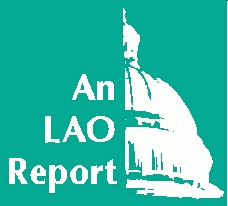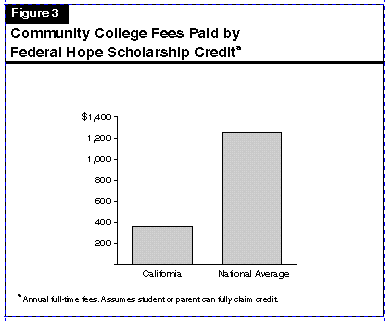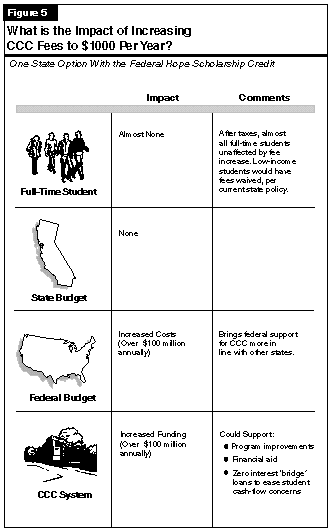
 |
Taking Advantage of New Federal
|
Introduction |
Last August, President Clinton signed into law the Taxpayer Relief Act of 1997. Part of the act creates the "Hope Scholarship" and "Lifetime Learning" tax credits, which will dramatically lower the after-tax price of higher education fees for most middle-income students (or their parents) by lowering their federal taxes. The credits create some unintended problems for the state, but also create opportunities to increase the effective federal subsidy of California's higher education programs |
Problems |
|
Opportunities |
The federal act opens up opportunities for the Legislature to increase the effective federal subsidy of our higher education programs and use the additional resources to improve those programs and improve higher education access. This strategy would require at least some fee increases. These increases, however, would be offset substantially-in some cases completely-by higher federal tax credits for students. For low-income students, fee increases could be offset fully by increased financial aid. |
Options |
This brief identifies several revenue and spending options that the Legislature has in responding to the problems and opportunities posed by the new tax credits. |
| Figure 1 | ||
| Key Features of the Hope Scholarship and
Lifetime Learning Tax Credits | ||
| Hope Scholarship | Lifetime Learning | |
| What years of college are covered? | First two years only. | Any year. |
| What students are eligible? | Must be at least half-time. | Part-time or full-time. |
| What costs are covered? | Tuition and fees only. | |
| What does the credit cover? | 100% of first $1,000 in
costs ($1,000). 50% of next $1,000 in costs ($500). |
20% of up to $5,000 in costs (up to $10,000 in 2003). |
| What is the maximum credit amount? | $1,500 per student. | $1,000 per tax return. |
| Effective dates | Academic terms beginning after December 31, 1997. | Academic terms beginning after June 30, 1998. |
| Are there income limits? | Credits begin to phase out at $80,000 adjusted gross income (AGI) and phase out completely at $100,000 for joint tax returns. For single returns, phase out begins at $40,000 and is complete at $50,000 AGI. | |
| Will poor students benefit? | Generally not. Poor students (and their parents) tend not to have the federal tax liability needed to receive the credits. The credits generally benefit middle-class students and parents. | |
| Figure 2 | |
| Hope Scholarship Tax Credit
Simple Example--UC Student | |
| 1998-99 | |
| Systemwide resident fee | $3,609 |
| Hope tax credita | -1,500 |
| Cost after taxes | $2,109 |
| a Assumes student or parent qualities for full amount of credit. | |
The new tax credits present California with novel opportunities to effectively increase federal resources for the state's higher education programs in ways that can improve the quality of instruction and poor Californians' access to higher education.
Given the state's current fee structure for the higher education segments, however, the
passage of the federal tax credits also poses some problems.

For the average state, the Hope Scholarship tax credit will pay $1,250 of the annual
costs of a full-time community college student. For California, it will pay only $360
(starting in 1998-99). The reason for this significant discrepancy is that Congress designed the Hope Scholarship credit to largely (but not completely) offset the national
average of community college fees-about $1,500 annually per full-time student. California's annual full-time fee level of $360 is far below the national average and, in fact, is
the lowest of all 50 states. Since the federal credit pays no more than the actual fees paid
by a student, California's per-student credit is effectively "capped" at $360 (for a student
taking 30 units a year).
| Figure 4 | ||
| Fees After Taxes for Full-Time Undergraduates--
Effects of Hope Scholarship Tax Credita | ||
| System | 1997-98
(Pre-Credit) |
1998-99
(With Credit) |
| Community colleges | $390 | -- |
| CSU | 1,584 | $253 |
| UC | 3,799 | 2,109 |
| a Hope credit is restricted to first two years of college. Above examples assume student or parent is able to take full advantage of the tax credit. Figures for 1998-99 include the impact of Chapter 853, Statutes of 1997. | ||
For example, although Chapter 853 reduces the "sticker price" of CCC courses from $13 per credit unit to $12 (or on an annual basis, from $390 down to $360), the after-tax price to the student is exactly the same at either sticker price-zero. Thus, the intended benefit of Chapter853's CCC fee reduction, which will be paid by the state's General Fund, effectively will go to the federal treasury, not CCC students. Specifically, for each CCC student receiving a Hope Scholarship credit, the fee reduction means:
A similar reverse subsidy occurs with CSU fees. Chapter 853 interacts with the federal tax credit in a way that sends 50 percent of the nominal benefit of the CSU fee reduction back to the federal treasury. Thus, of the $78 reduction in the sticker price for a
full-time academic year, students will enjoy an after-tax reduction of only $39.
Chapter853's fee reduction for full-time UC undergraduates using the Hope Scholarship
credit is not dissipated. This is because UC's fees for a full-time academic year are well
above the level at which the Hope Scholarship credit amount is maximized ($2,000).
Maximizing State Resources. The state could raise fees at the three segments in a way that maximizes the effective federal subsidy of California's higher education programs. State programs would, in effect, "capture" much of the after-tax benefit provided to students and parents by the tax credits. Many students would pay either the same or less, after taxes, than they have in recent years, but part-time and higher-income students could pay substantially more. Effective federal resources for the state's higher education programs could increase by $500 million or more annually.
Protecting Community College Role in Baccalaureate Education. Alternatively, the state could restore the after-tax fee differentials between the community colleges, CSU, and UC-needed to avoid a costly shift of students from the colleges to the universities-by establishing a lower division fee surcharge at CSU and UC. The Legislature could offset the fee surcharge later in a student's career by, for example, granting a refund of senior-year fees when the student graduates. This would act as an additional incentive for graduation.
A Win/Win Approach: More State Resources at No Cost to Students. Finally, the
state could raise community college fees in a way that increases California's federal
subsidy yet at the same time leaves most, or all, of the after-tax benefit with students
and parents. Under this approach the state could increase the flow of federal resources
to California (by $100 million a year or more), with little or no after-tax fee increase for
most students. For example, if the state increased annual full-time fees from the $360
authorized for 1998-99 to as much as $1,000, students able to use the Hope Scholarship
credit would still pay-after taxes-nothing for courses. This is because Congress designed
the credit as a dollar-for-dollar offset for the first $1,000 of annual fees. Figure 5 shows
the impact of such a fee increase.

Protecting Low-Income Students. Low-income students generally are unaffected by
the tax credits because they lack the tax liability needed to use the credits. Generally,
they also are unaffected by student fee changes (up or down) because current state
policies (1) exempt them from fees-such is the case for 39 percent of all community college students-or (2) pay their fees with grants. The Legislature could readily modify
these waiver and grant policies to make sure that no student who is too poor to use the
tax credits would be affected by any fee increases.
| Acknowledgements This report was prepared by Robert Turnage, under the supervision of Paul Warren. The Legislative Analyst's Office (LAO) is a nonpartisan office which provides fiscal and policy information and advice to the Legislature. |
Publications
To request publications call (916) 445-2375.
|